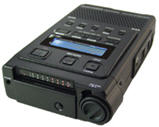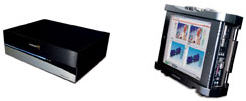From CUNY Academic Commons
Contents |
iPod with Microphone (Audio only)
Some iPods can record your voice if you connect a microphone to the docking port (not the Shuffle, and not the most recent generation). A really effective microphone is made by Belkin called TuneTalk.
Pros:
- Really simple to use/record – wear it in a breast pocket or on an armband while you teach
- Produces high quality recordings in .WAV format
- Relatively inexpensive – (~$250)
- iPod nano 2nd Gen (~$180)
- Belkin Microphone (~$70)
Cons:
- Recordings are limited to the length of iPod battery life with microphone attached – usually about an hour
- The Belkin only works with the 4th gen iPod Video and 2nd Gen iPod-nano (last year’s models)
- Captures voice only – however, after class audio can be synchronized with images, PowerPoint slides, etc. using a product like Camtasia (an additional ~$200)
- No automation – file transfers, output file creation, XML file must all be done manually
Marantz PMD660 Digital Recorder + wireless microphone (Audio only)
Pros:
- Easy to Use
- Very high quality recordings
- Uses inexpensive Flash Memory – larger means more hours of recording
- If an outlet is not available it can operate for 4 hrs on 4-AA batteries
- Built-in condenser mic – but a wired or wireless mic will produce much better results
- Has Two XLR mic connections with +48v phantom power
- Built-in USB port for transferring recordings to your computer or just move the memory card to the computer if it has a reader
Cons:
- Expensive (~$700)
- Marantz PMD660 (~$500)
- Flash Memory Card (2GB ~$30)
- Wireless Lavalier Microphone (~$200)
- Captures voice only – however, after class audio can be synchronized with images, PowerPoint slides, etc. using a product like Camtasia (an additional ~$200)
- No automation – file transfers, output file creation, XML file must all be done manually
Bluetooth Microphone with Camtasia
Pros:
- Records both audio and images, PowerPoint slides, etc. – fully synchronized
- Audio Quality OK but not great
Cons:
- Can be tricky to set up and use
- Moderately expensive (~$400)
- Camtasia Studio (~$200)
- Bluetooth Microphone (~$170)
- Bluetooth Receiver (~$30)
- No automation – file transfers, output file creation, XML file must all be done manually
Mediasite
Pros:
- Broadcasts Live on the Internet
- Records both video, audio, and images, PowerPoint slides, etc. – fully synchronized
* Maintains archived recordings – you need a Windows Media streaming server – automatically - Provides a full user interface for accessing archived recordings
- Rack mount and portable versions exist
Cons:
- Very Expensive (~$18,000 installed + yearly maintenance + Windows Streaming Server)
- Doesn’t scale easily to multiple simultaneous classrooms
- Windows Media format only – you will have to convert manually for iTunesU
- Very limited editing of recordings
- Tricky to get working for live broadcast – mostly network issues
Echo360
(formerly Apreso Anystream + Lectopia) – http://www.echo360.com/
Pros:
- Scalable
- Capture can be fully automated (scheduled) if you wish, or partly automated
- Multiple output formats – H.264 raw video format
Cons:
- Expensive
o For the hardware version you need a server, a capture license & a capture appliance – plus the multimedia equipment in the classroom – computer, projector, etc)
o For the software version you need a server, a capture license (~$1,500 per year per room) – plus the multimedia equipment in the classroom – computer, projector, etc)
+ Echo360 capture license (~$2,250 per room per year)
+ Hardware capture appliance (~$2000 per room)
+ Installation (~$1,000)
+ Server Hardware (~$2,000-$5,000)
- Limited editing – removal of contents only – cannot add
[[Category:]]





